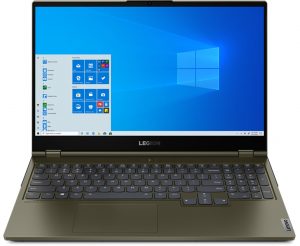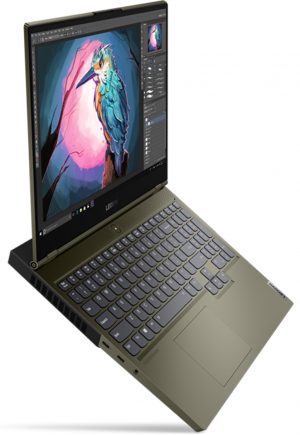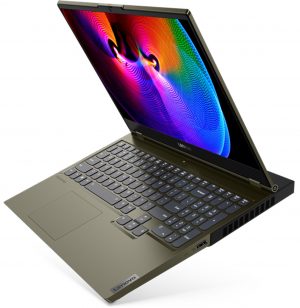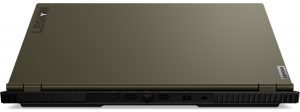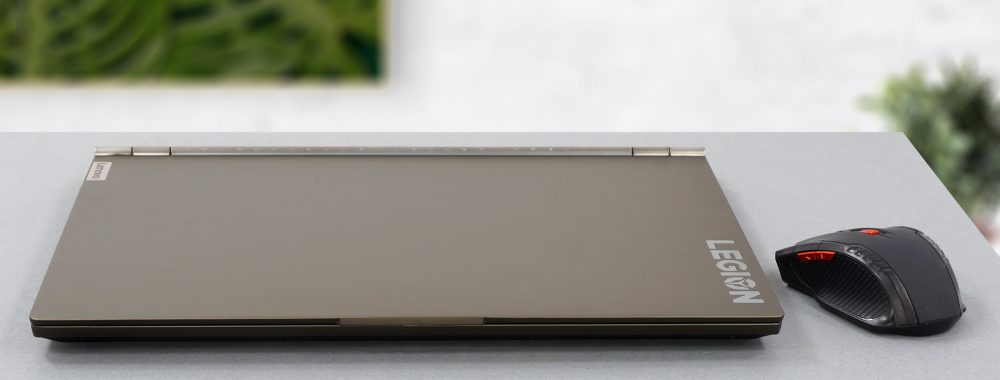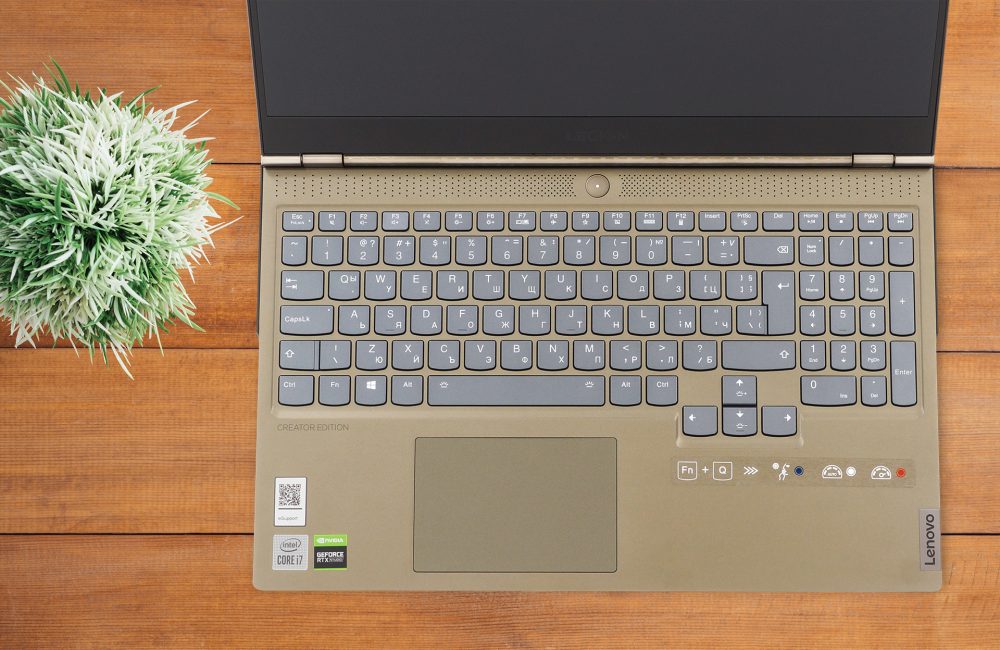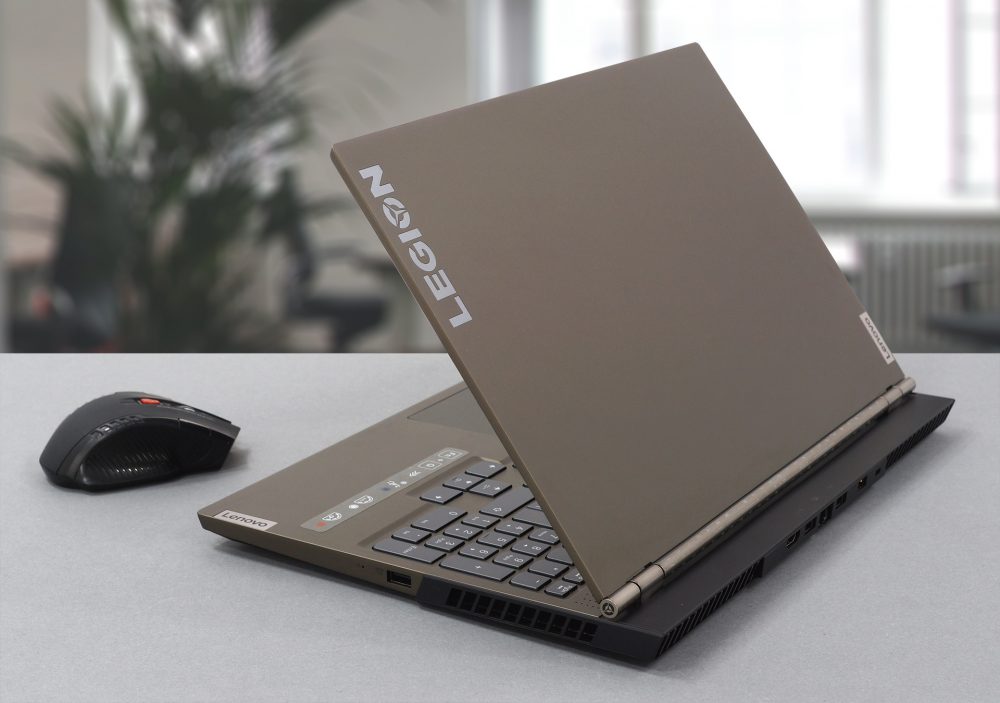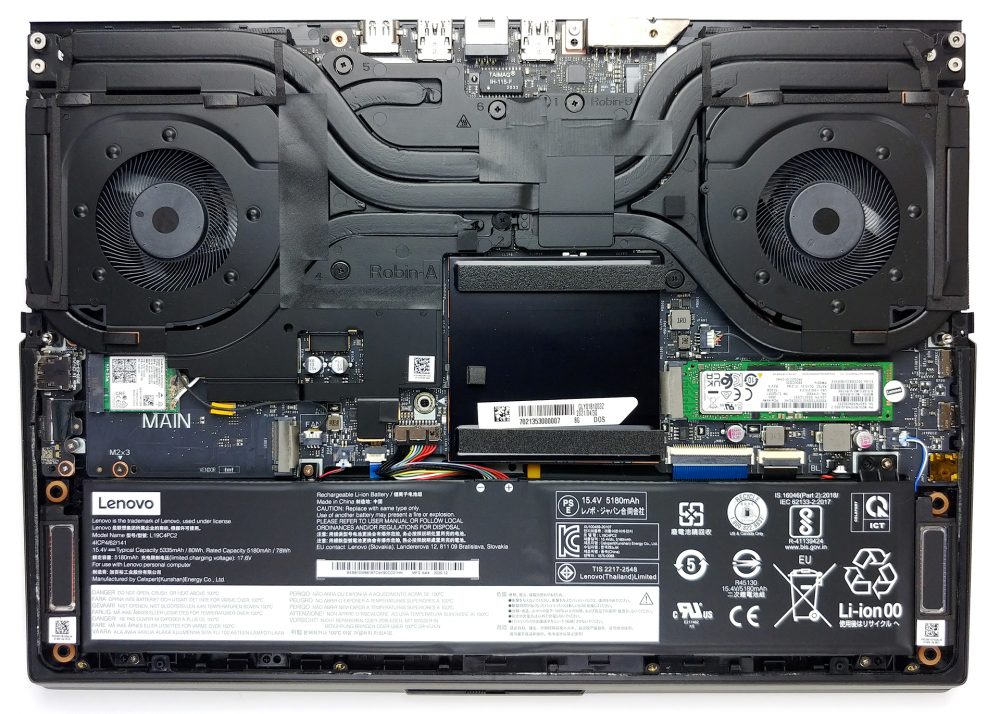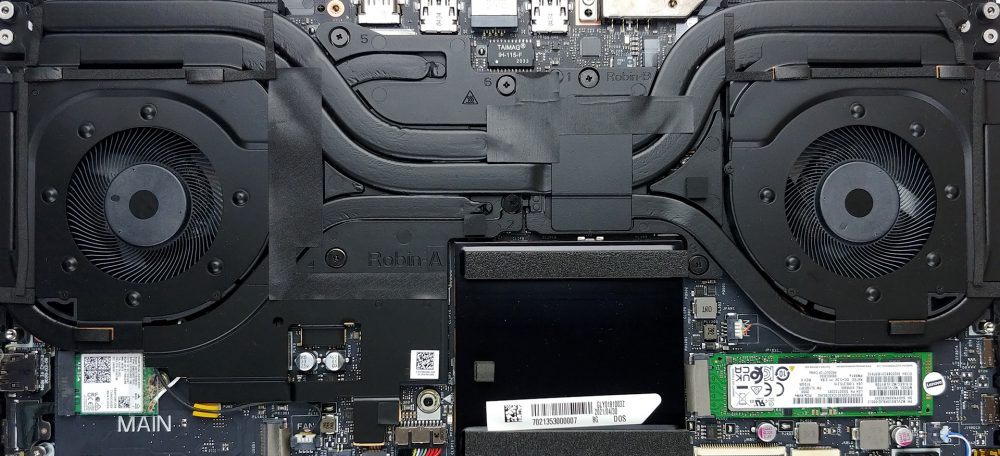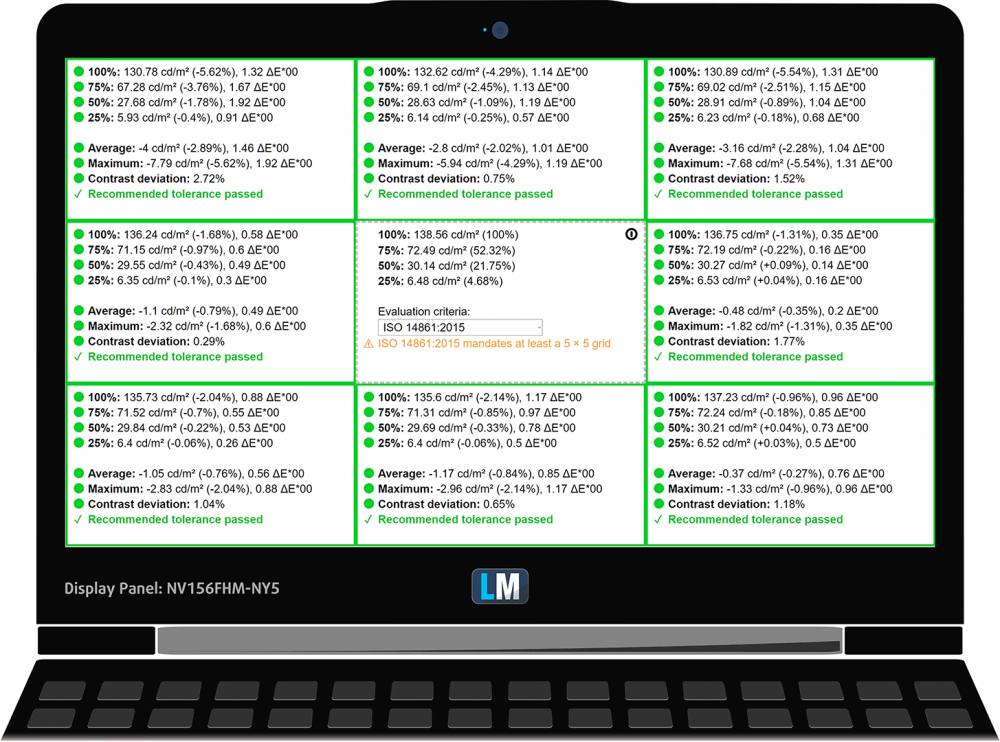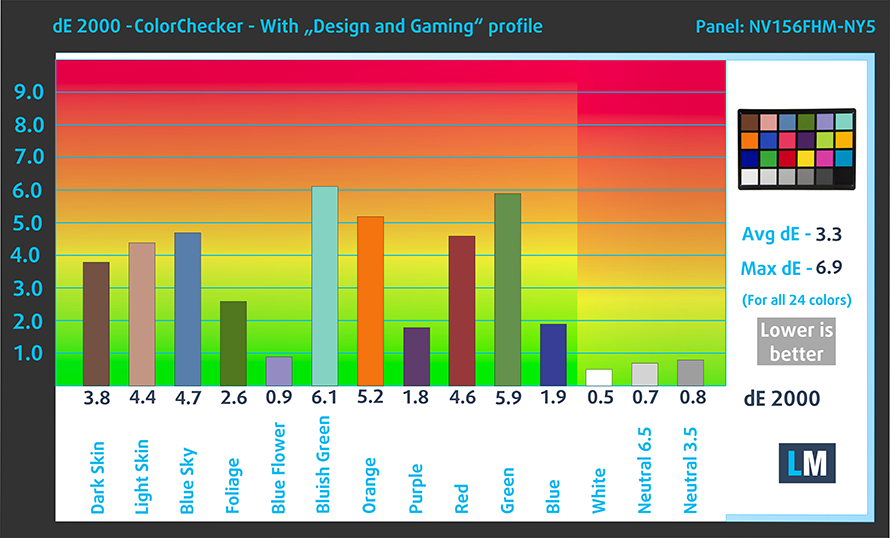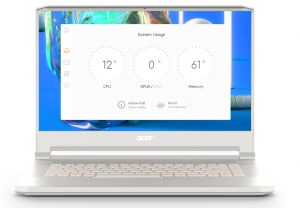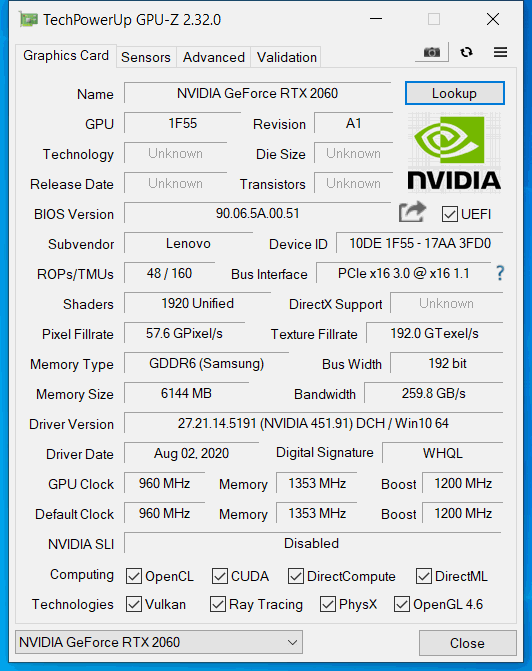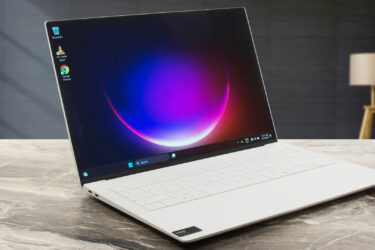Lenovo Legion C7 (15) review – another member of the “Creator” club
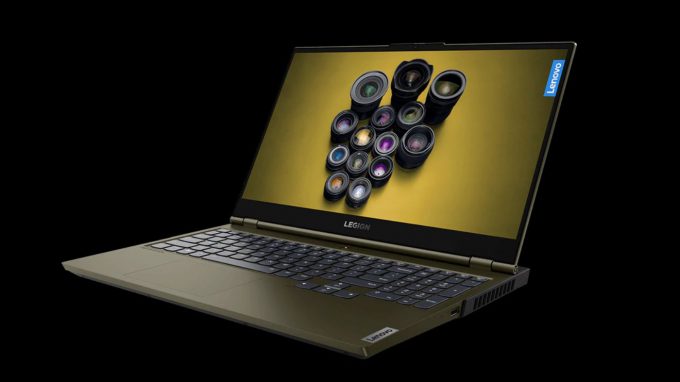 The Lenovo Legion Creator 7 (15), or the Legion C7 (15) as it’s more popular, lives in a rather new premium segment of the market. It is the so-called “Creator” niche, where manufacturers compete for the regards of YouTubers, designers, videographers, and other types of content creators. Its competition includes the MSI Creator 15 A10Sx, the ConceptD series of Acer, the HP Envy 15 (15-ep0000), the MacBook Pro 16’s of the world, and pretty much all gaming notebooks on the market.
The Lenovo Legion Creator 7 (15), or the Legion C7 (15) as it’s more popular, lives in a rather new premium segment of the market. It is the so-called “Creator” niche, where manufacturers compete for the regards of YouTubers, designers, videographers, and other types of content creators. Its competition includes the MSI Creator 15 A10Sx, the ConceptD series of Acer, the HP Envy 15 (15-ep0000), the MacBook Pro 16’s of the world, and pretty much all gaming notebooks on the market.
But what exactly is the difference between a Content Creator laptop and a gaming device. Although both can do each other’s job, the main difference is the presentation. Even though manufacturers are doing a good job in disguising their gaming notebooks, they still have the passive-aggressive vibe of something that you want to play games with, instead of a unit that delivers your primary income.
This is why all of the aforementioned laptops, as well as the Legion C7 (15), are super sleek when it comes to looks. And they offer great displays, as well. As far as we know, there is only one screen option for today’s notebook, and it is a 1080p 144Hz IPS-type panel, that should deliver 100% Adobe RGB coverage, up to 500 nits of brightness, and it even supports goodies like HDR 400, Dolby Vision, and G-Sync. And this, ladies and gentleman, is the pinnacle of 1080p panels nowadays.
The expectations are so high, in fact, that even the hardware gets in its shadow. And we are talking about up to Core i9-10980HK, and RTX 2080 Super Max-Q, so this laptop is no slouch.
You can check the prices and configurations in our Specs System: https://laptopmedia.com/series/lenovo-legion-c7-15/
Contents
Specs Sheet
- HDD/SSD
- up to 1000GB SSD
- M.2 Slot
- 2x 2280 M.2 NVMe slots See photo
- RAM
- up to 32GB
- OS
- Windows 10 Pro, No OS
- Battery
- 80Wh
- Body material
- Aluminum
- Dimensions
- 359.34 x 259.04 x 19.9 mm (14.15" x 10.20" x 0.78")
- Weight
- 2.25 kg (5 lbs)
- Ports and connectivity
- 1x USB Type-A
- 3.2 Gen 1 (5 Gbps)
- 2x USB Type-A
- 3.2 Gen 2 (10 Gbps)
- 1x USB Type-C
- 3.2 Gen 1 (5 Gbps), DisplayPort
- 1x USB Type-C
- 3.2 Gen 2 (10 Gbps), Thunderbolt 3, DisplayPort
- HDMI
- 2.0
- Card reader
- Ethernet LAN
- 10, 100, 1000 Mbit/s
- Wi-Fi
- 802.11ax
- Bluetooth
- 5.0
- Audio jack
- 3.5mm Combo Jack
- Features
- Fingerprint reader
- Web camera
- HD
- Backlit keyboard
- Microphone
- Dual Array Microphone
- Speakers
- 2x 2W, Dolby Atmos
- Optical drive
- Security Lock slot
All Lenovo Legion C7 (15″) configurations
What’s in the box?
This notebook comes in a pretty well-designed package, that includes a couple of boxes, good foam padding, and a 230W power adapter.
Design and construction
Generally, the Legion C7 (15) is a beautiful piece of machinery, that comes in a Dark Moss greenish color on top of an aluminum chassis. Of course, as a member of the Legion brand, it has the signature plastic vent seemingly attached to the back and bottom of the device. Here, both the lid and the base are very sturdy, with some deck flex observed on the keyboard. In terms of measurements, you get a 19.9mm profile and a weight of 2.25 kilos – exactly the same as the “regular” Legion 7 (15).
Also, we are happy to see that the lid opens with a single hand, and griping it is made easy by a notch protruding from the top bezel. It’s worth mentioning that the spiked star in the middle of the “O” in the Legion logo on the back glows up. On the front, however, we see pretty thin bezels (except for the bottom one) around the Anti-glare-finished display, as well as an HD camera with a privacy shutter.
Then comes the keyboard. Generally, it is a good unit, that has an RGB backlight, NumberPad, and huge Arrow keys. Now, the feedback is clicky, yet quiet, however, the key travel comes a bit short. This makes it slightly uncomfortable for gaming, but still – very good for typing. Also, there are the usual performance modes, which can be toggled by simultaneously pressing the Function and “Q” keys. The changes are reflected on the Power button LED, which glows in Blue for “Quiet” mode, in White for “Auto” and in Red for “Extreme” performance.
Next, we have the touchpad, which has a glass-imitating Mylar cover, which provides a very good gliding experience, and accurate tracking response, despite the average size.
And on the bottom, you will see the speaker cutouts and a huge ventilation grill. In fact, the holes are so big that small rats can pass through. Hot air, respectively, escapes from the back and one vent on each side of the notebook. By the way, even though Lenovo supplied their notebook with such a big ventilation grill, the fans draw some of the air through the keyboard, and through the grills above it.
Ports
On the left side of the notebook, there is one Thunderbolt 3 connector, as well as one USB Type-C 3.2 (Gen. 1) port, that has DisplayPort 1.4 output capabilities, and an audio jack. Then, on the right, you get one USB Type-A 3.2 (Gen. 1) port, which leaves the rest of the I/O on the back. This includes the proprietory power plug, two USB Type-A 3.2 (Gen. 2) ports, an RJ-45 connector, and an HDMI 2.0 connector. Still no SD card slot around.
Disassembly, upgrade options, and maintenance
To take this laptop apart, you have to remove the bottom panel. And to do so, you need to undo 10 Phillips-head screws and pry the panel with a plastic tool.
Powering the laptop, when it’s away from the plug, is an 80Wh battery pack.
Here, the memory is hiding beneath a metal shroud. After you remove it, you will see the two SODIMM slots, which should fit up to 64GB of DDR4 RAM in total. Storage-wise, there are two M.2 PCIe x4 slots.
Last but not least, we have the cooling. The CPU and the GPU are cooled by a total of five heat pipes, with some metal heat spreaders, and a further heat pipe helping with the VRM and graphics memory temperatures. Also, you will see a total of four heat sinks, and two behemoth fans.
Display quality
Lenovo Legion C7 (15) in the configuration we tested has a Full HD 144Hz IPS panel with a model number BOE NV156FHM-NY5 (BOE08EA). Its diagonal is 15.6″ (39.62 cm), and the resolution 1920 х 1080 pixels. The screen ratio is 16:9, and we are looking at a pixel density of – 142 ppi, and a pitch of 0.18 х 0.18 mm. The screen turns into Retina when viewed at distance equal to or greater than 60cm (24″) (from this distance one’s eye stops differentiating the separate pixels, and it is normal for looking at a laptop).
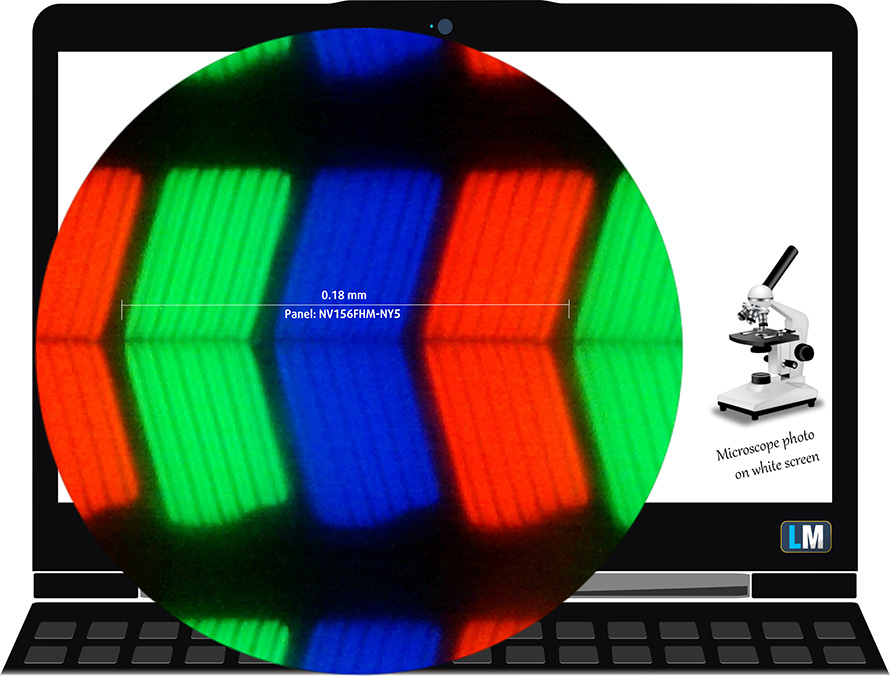
Viewing angles are excellent. We offer images at 45° to evaluate image quality.
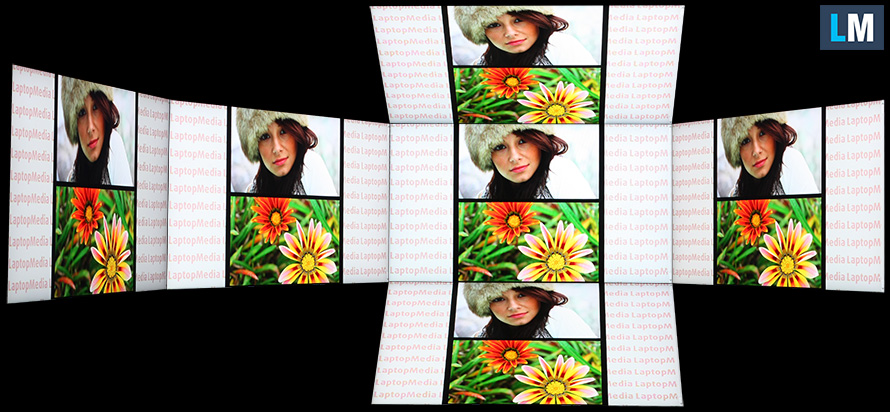
We measured a maximum brightness of 510 nits in the middle of the screen and 500 nits as an average for the whole area, with a maximum deviation of 6%. The Correlated Color Temperature on a white screen is 6300K – slightly warmer than the optimal for the sRGB standard of 6500K.
In the illustration below you can see how the display performs from a uniformity perspective. In other words, the leakage of light from the light source.
Values of dE2000 over 4.0 should not occur, and this parameter is one of the first you should check if you intend to use the laptop for color-sensitive work. The contrast ratio is good – 1180:1.
To make sure we are on the same page, we would like to give you a little introduction to the sRGB color gamut and the Adobe RGB. To start, there’s the CIE 1976 Uniform Chromaticity Diagram that represents the visible specter of colors by the human eye, giving you a better perception of the color gamut coverage and the color accuracy.
Inside the black triangle, you will see the standard color gamut (sRGB) that is being used by millions of people on HDTV and on the web. As for the Adobe RGB, this is used in professional cameras, monitors, etc for printing. Basically, colors inside the black triangle are used by everyone and this is the essential part of the color quality and color accuracy of a mainstream notebook.
Still, we’ve included other color spaces like the famous DCI-P3 standard used by movie studios, as well as the digital UHD Rec.2020 standard. Rec.2020, however, is still a thing of the future and it’s difficult for today’s displays to cover that well. We’ve also included the so-called Michael Pointer gamut, or Pointer’s gamut, which represents the colors that naturally occur around us every day.
The yellow dotted line shows Lenovo Legion C7 (15)’s color gamut coverage.
Its display covers fully (99.5%) the colors of the sRGB/ITU-R BT.709 (web/HDTV standard) in CIE1976. Moreover, the Primary RGB values are a lot more saturated than the standard seen on the Web, thus enabling a Gamut volume of 130% of sRGB, and 96% of DCI-P3 coverage, making the image attractive and vibrant.
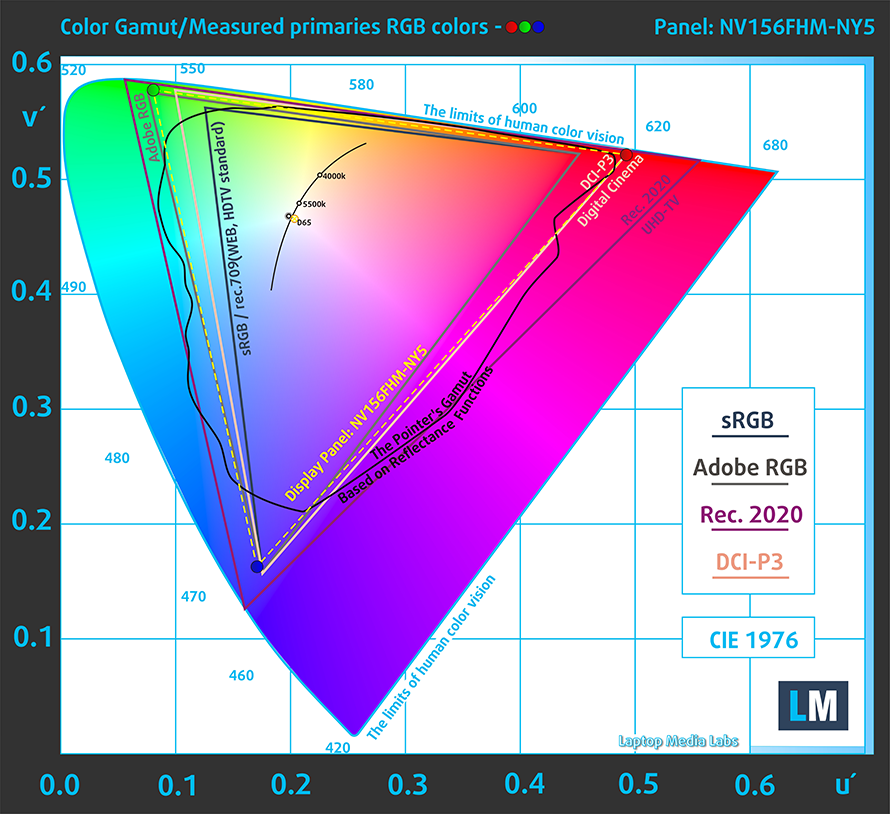
Our “Design and Gaming” profile delivers optimal color temperature (6500K) at 140 cd/m2 luminance and sRGB gamma mode.
We tested the accuracy of the display with 24 commonly used colors like light and dark human skin, blue sky, green grass, orange, etc. You can check out the results at factory condition and also, with the “Design and Gaming” profile.
Below you can compare the scores of Lenovo Legion C7 (15) with the default settings (left), and with the “Gaming and Web design” profile (right).
The next figure shows how well the display is able to reproduce really dark parts of an image, which is essential when watching movies or playing games in low ambient light.
The left side of the image represents the display with stock settings, while the right one is with the “Gaming and Web Design” profile activated. On the horizontal axis, you will find the grayscale, and on the vertical axis – the luminance of the display. On the two graphs below you can easily check for yourself how your display handles the darkest nuances but keep in mind that this also depends on the settings of your current display, the calibration, the viewing angle, and the surrounding light conditions.
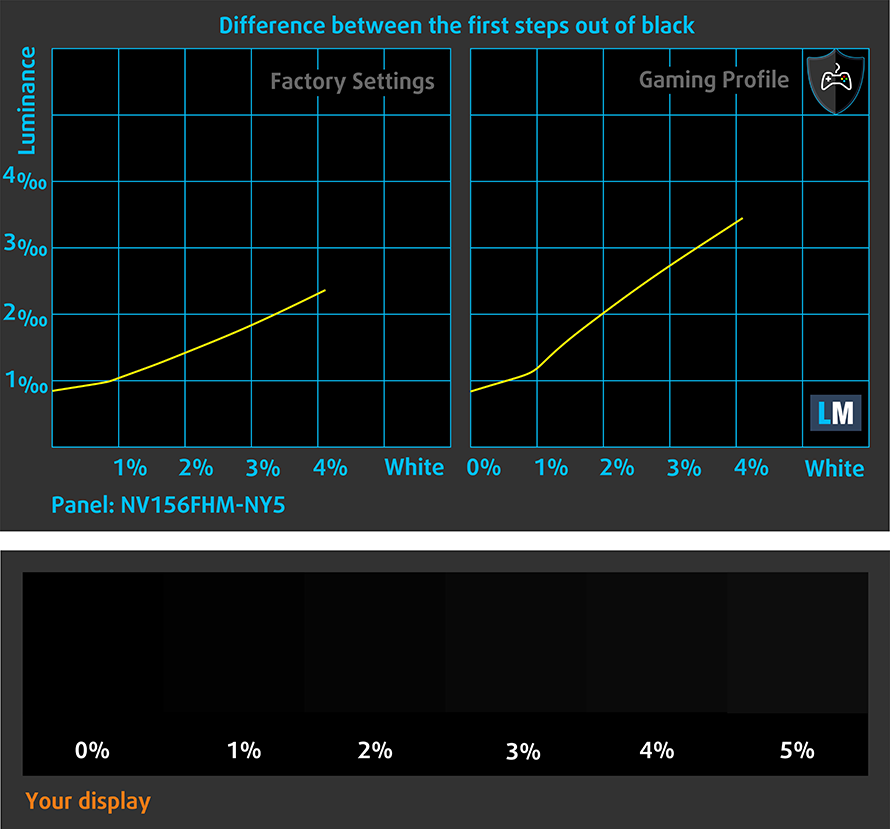
Response time (Gaming capabilities)
We test the reaction time of the pixels with the usual “black-to-white” and “white-to-black” method from 10% to 90% and vice versa.
We recorded Fall Time + Rise Time = 9 ms.
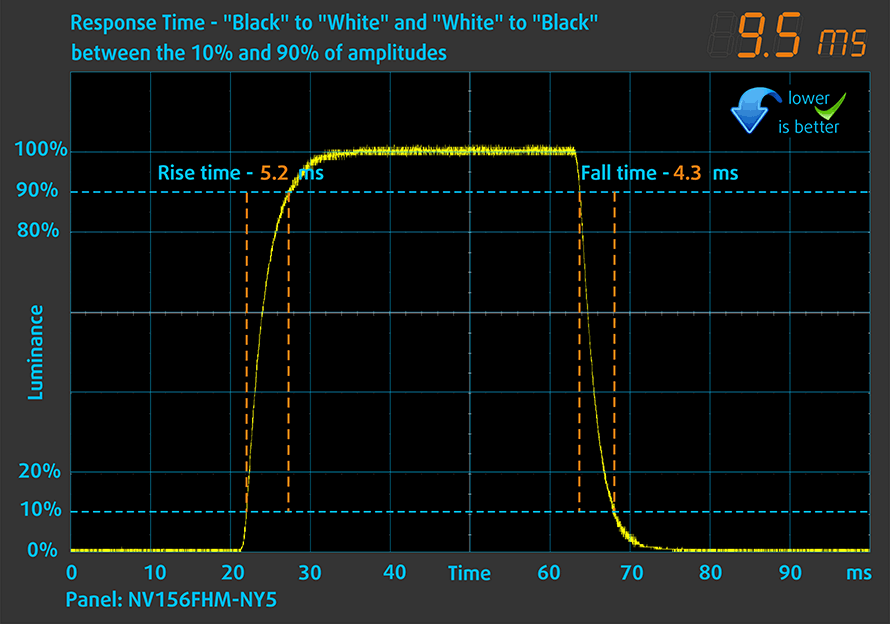
After that, we test the reaction time of the pixels with the usual “Gray-to-Gray” method from 50% White to 80% White and vice versa between 10% and 90% of the amplitude.

PWM (Screen flickering)
Pulse-width modulation (PWM) is an easy way to control monitor brightness. When you lower the brightness, the light intensity of the backlight is not lowered, but instead turned off and on by the electronics with a frequency indistinguishable to the human eye. In these light impulses, the light/no-light time ratio varies, while brightness remains unchanged, which is harmful to your eyes. You can read more about that in our dedicated article on PWM.
Lenovo Legion C7 (15)’s display doesn’t flicker at any brightness level. This provides comfort in extended periods of use.

Blue light emissions
Installing our Health-Guard profile not only eliminates PWM but also reduces the harmful Blue Light emissions while keeping the colors of the screen perceptually accurate. If you’re not familiar with the Blue light, the TL;DR version is – emissions that negatively affect your eyes, skin, and your whole body. You can find more information about that in our dedicated article on Blue Light.
Conclusion
Lenovo Legion C7 (15)’s 144Hz IPS-type panel has a Full HD resolution, comfortable viewing angles, good contrast ratio, and very high maximum brightness. Additionally, it doesn’t use PWM for brightness adjustment, and the color coverage is exceptional – 96% of the DCI-P3 gamut. On the other hand, we found that it falls short of the promises of a dE <2.0, even with calibration done by us.
Nevertheless, the laptop supports HDR 400, Dolby Vision, and G-Sync, and it has very quick pixel response times, which makes it a great tool for entertainment.
Buy our profiles
Since our profiles are tailored for each individual display model, this article and its respective profile package are meant for Lenovo Legion C7 (15) configurations with 15.6″ FHD IPS BOE NV156FHM-NY6 (BOE08EA).
*Should you have problems with downloading the purchased file, try using a different browser to open the link you’ll receive via e-mail. If the download target is a .php file instead of an archive, change the file extension to .zip or contact us at [email protected].
Read more about the profiles HERE.
In addition to receiving efficient and health-friendly profiles, by buying LaptopMedia's products you also support the development of our labs, where we test devices in order to produce the most objective reviews possible.

Office Work
Office Work should be used mostly by users who spend most of the time looking at pieces of text, tables or just surfing. This profile aims to deliver better distinctness and clarity by keeping a flat gamma curve (2.20), native color temperature and perceptually accurate colors.

Design and Gaming
This profile is aimed at designers who work with colors professionally, and for games and movies as well. Design and Gaming takes display panels to their limits, making them as accurate as possible in the sRGB IEC61966-2-1 standard for Web and HDTV, at white point D65.

Health-Guard
Health-Guard eliminates the harmful Pulse-Width Modulation (PWM) and reduces the negative Blue Light which affects our eyes and body. Since it’s custom tailored for every panel, it manages to keep the colors perceptually accurate. Health-Guard simulates paper so the pressure on the eyes is greatly reduced.
Get all 3 profiles with 33% discount
Sound
Lenovo Legion C7 (15)’s speakers produce a loud sound with relatively good quality. However, the lid, mid and high tones have some deviations in clarity, especially at high volume.

Drivers
All of the drivers and utilities for this notebook can be found here: https://pcsupport.lenovo.com/us/en/products/laptops-and-netbooks/legion-series/legion-c7-15imh05/downloads/driver-list
Battery
Now, we conduct the battery tests with Windows Better performance setting turned on, screen brightness adjusted to 120 nits, and all other programs turned off except for the one we are testing the notebook with. This notebook’s 80Wh battery pack lasts for 6 hours and 53 minutes of Web browsing and 6 hours and 51 minutes of video playback.
In order to simulate real-life conditions, we used our own script for automatic web browsing through over 70 websites.
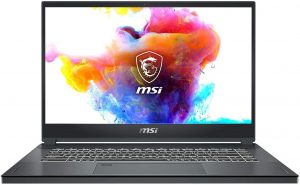
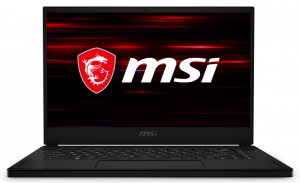
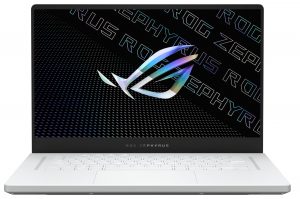
For every test like this, we use the same video in HD.



CPU options
You can get this device with pretty much the entire Comet Lake-H specter of CPUs. This includes the Core i5-10300H, Core i7-10750H, Core i7-10875H, and Core i9-10980HK.
Results are from the Cinebench 20 CPU test (the higher the score, the better)
Results are from our Photoshop benchmark test (the lower the score, the better)
GPU options
And in terms of graphics, all of the options are pretty capable – GeForce GTX 1660 Ti, RTX 2060, RTX 2070 Max-Q, RTX 2070 Super Max-Q, and RTX 2080 Super Max-Q.
Results are from the 3DMark: Time Spy (Graphics) benchmark (higher the score, the better)
Results are from the 3DMark: Fire Strike (Graphics) benchmark (higher the score, the better)
Results are from the Unigine Superposition benchmark (higher the score, the better)
Gaming tests

| Far Cry 5 | Full HD, Normal (Check settings) | Full HD, High (Check settings) | Full HD, Ultra (Check settings) |
|---|---|---|---|
| Average fps | 105 fps | 97 fps | 91 fps |

| Rise of the Tomb Raider (2016) | Full HD, Medium (Check settings) | Full HD, Very High (Check settings) | Full HD, MAX (Check settings) |
|---|---|---|---|
| Average fps | 134 fps | 97 fps | 46 fps |

| Tom Clancy’s Ghost Recon Wildlands | Full HD, High (Check settings) | Full HD, Very High (Check settings) | Full HD, Ultra (Check settings) |
|---|---|---|---|
| Average fps | 81 fps | 71 fps | 47 fps |

| Shadow of the Tomb Raider (2018) | Full HD, Medium (Check settings) | Full HD, High (Check settings) | Full HD, Highest (Check settings) |
|---|---|---|---|
| Average fps | 92 fps | 87 fps | 55 fps |
Temperatures and comfort
Max CPU load
In this test we use 100% on the CPU cores, monitoring their frequencies and chip temperature. The first column shows a computer’s reaction to a short load (2-10 seconds), the second column simulates a serious task (between 15 and 30 seconds), and the third column is a good indicator of how good the laptop is for long loads such as video rendering.
Average core frequency (base frequency + X); CPU temp.
| Intel Core i7-10750H (45W TDP) | 0:02 – 0:10 sec | 0:15 – 0:30 sec | 10:00 – 15:00 min |
|---|---|---|---|
| Lenovo Legion C7 (15) | 3.76 GHz (B+45%) @ 81°C | 3.79 GHz (B+46%) @ 89°C | 3.62 GHz (B+39%) @ 84°C |
| HP ZBook Power G7 | 3.71 GHz (B+43%) @ 87°C | 3.60 GHz (B+38%) @ 95°C | 3.13 GHz (B+20%) @ 79°C |
| HP Omen 15 2019 (15-dh1000) | 4.03 GHz (B+55%) @ 96°C | 3.87 GHz (B+45%) @ 97°C | 3.65 GHz (B+40%) @ 96°C |
| MSI GF65 Thin 10Sx | 3.59 GHz (B+38%) @ 95°C | 3.48 GHz (B+34%) @ 95°C | 3.08 GHz (B+18%) @ 91°C |
| HP Pavilion Gaming 16 (16-a0000) | 3.74 GHz (B+44%) @ 97°C | 3.17 GHz (B+22%) @ 88°C | 2.98 GHz (B+15%) @ 78°C |
| HP Omen 15 2020 (15-ek0000) | 3.55 GHz (B+37%) @ 71°C | 2.88 GHz (B+11%) @ 62°C | 2.81 GHz (B+8%) @ 70°C |
| Acer Predator Helios 300 (PH315-53) | 3.56 GHz (B+37%) @ 76°C | 3.52 GHz (B+35%) @ 85°C | 2.98 GHz (B+15%) @ 75°C |
| Dell G5 15 5500 | 3.82 GHz (B+47%) @ 75°C | 3.63 GHz (B+40%) @ 99°C | 3.01 GHz (B+16%) @ 81°C |
| ASUS ROG Strix G15 G512 | 4.16 GHz (B+60%) @ 81°C | 3.99 GHz (B+53%) @ 95°C | 3.52 GHz (B+35%) @ 87°C |
| Acer Nitro 5 (AN515-55) | 3.02 GHz (B+16%) @ 82°C | 3.04 GHz (B+17%) @ 92°C | 2.67 GHz (B+3%) @ 92°C |
| Lenovo Legion 7 (15) | 3.78 GHz (B+45%) @ 80°C | 3.69 GHz (B+42%) @ 83°C | 3.51 GHz (B+35%) @ 83°C |
So, here we got a very good cooling on the CPU – better than almost everything on the market, and pretty similar to the Legion 7 (15).
Real-life gaming
| NVIDIA GeForce RTX 2060 | GPU frequency/ Core temp (after 2 min) | GPU frequency/ Core temp (after 30 min) | GPU frequency/ Core temp (after 30 min + fan boost) |
|---|---|---|---|
| Lenovo Legion C7 (15) | 1657 MHz @ 67°C | 1667 MHz @ 65°C | – |
| MSI Creator 15 A10Sx | 1805 MHz @ 75°C | 1794 MHz @ 78°C | 1802 MHz @ 76°C (High Performance) |
| MSI GL65 10Sx | 1805 MHz @ 75°C | 1794 MHz @ 78°C | 1802 MHz @ 76°C |
| Dell G7 17 7700 | 1468 MHz @ 72°C | 1440 MHz @ 77°C | 1450 MHz @ 75°C |
| Dell G7 17 7790 | 1432 MHz @ 73°C | 1462 MHz @ 73°C | – |
| MSI GF65 Thin 10Sx | 1434 MHz @ 84°C | 1421 MHz @ 86°C | – |
| Acer Predator Helios 300 (PH315-53) | 1506 MHz @ 77°C | 1457 MHz @ 82°C | 1671 MHz @ 76°C |
| MSI GL65 9SE | 1590 MHz @ 71°C | 1588 MHz @ 73°C | 1590 MHz @ 68°C |
| ASUS ROG Zephyrus M GU502 | 1454 MHz @ 76°C | 1394 MHz @ 85°C | – |
| MSI GS65 Stealth 8SE | 1305 MHz @ 77°C | 1267 MHz @ 80°C | – |
| Lenovo Legion Y740 | 1526 MHz @ 70°C | 1499 MHz @ 74°C | – |
This version of the RTX 2060 works at 95W – 15W more than that of the MSI Creator 15 (A10Sx). Additionally, the temperatures are very low for the amount of performance you get.
Gaming comfort
Indeed, this results in a lot of noise, but mostly when you use the High Performance preset. On the bright side, the outer temperature is in check with a maximum value of about 43°C.
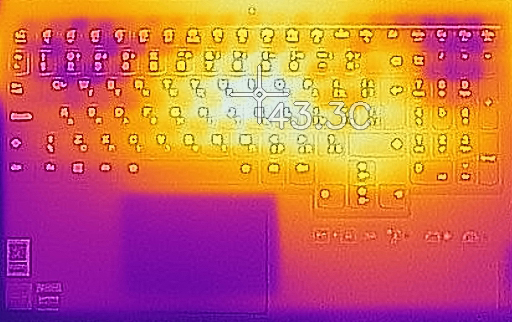
Verdict
Undoubtedly, the Legion C7 (15) is one hell of a device. It is slender, relatively light, has premium build quality, and nice cool touch, thanks to the aluminum chassis. Its keyboard is top-notch (with a tiny remark on the short key travel). And although we were not really able to achieve the 8 hours of battery life stated by Lenovo, we got about 7 hours which is still decent, given the uncompromising hardware and 144Hz display.
Speaking of which, Lenovo Legion C7 (15)’s 144Hz IPS-type panel (BOE NV156FHM-NY5 (BOE08EA)) has a Full HD resolution, comfortable viewing angles, good contrast ratio, and very high maximum brightness. Additionally, it doesn’t use PWM for brightness adjustment, and the color coverage is exceptional – 96% of the DCI-P3 gamut. On the other hand, we found that it falls short of the promises of a dE <2.0, even with calibration done by us.
Nevertheless, the laptop supports HDR 400, Dolby Vision, and G-Sync, and it has very quick pixel response times, which makes it a great tool for entertainment.
Sure, you also get the now mandatory Wi-Fi 6 support, as well as Thunderbolt 3 connectivity, and a whole load of other I/O, but it happens that Lenovo wasn’t able to fit an SD card slot anywhere… on a Creator-labeled notebook. Not that we want to say something, but MSI did include one on their Creator 15 (A10SX).
What this notebook has, though, is good cooling. Not only did it handle our configuration with the Core i7-10750H, and the RTX 2060, but if the similarities with the Legion 7 (15) are not coincidental (and we believe they aren’t), the top of the line setup should come with a vapor chamber.
Ultimately, the hardware is great, and we really doubt that you will have any issue with your content creation work, but you have to keep in mind that the colors (at least on our unit) are not accurate enough for color-sensitive work. And despite the power of the Comet Lake-H CPUs, AMD is the new king in the mobile CPU world, so we would like to see an AMD version of this notebook.
Pros
- Great input devices (RGB backlight on the keyboard and illuminated Legion logo)
- Takes up to 64GB of DDR4 memory and has two M.2 slots
- The display is PWM-free (BOE NV156FHM-NY5)
- Full sRGB coverage + 96% of the DCI-P3 gamut (BOE NV156FHM-NY5)
- Capable hardware inside of a thin, relatively light, and well-built chassis
- Thunderbolt 3 connectivity, multiplexer toggle (for direct connection of the dGPU to the display)
- HDR 400, Dolby Vision, G-Sync, and great speakers
- Good (although loud) cooling
Cons
- Lacks an SD card reader
- Unsatisfactory color accuracy (BOE NV156FHM-NY5)
You can check the prices and configurations in our Specs System: https://laptopmedia.com/series/lenovo-legion-c7-15/
